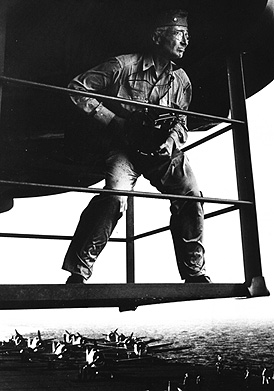|
Help
me add to this section. Submit your ideas or articles to bcolley@snet.net
Follow the hyperlinks
to view :
Joel Barlow, Anna
Huntington , Charles Ives, Mark
Twain
|
Steichen,
Edward (1879-1973), American photographer, who sought
an emotional, impressionistic rendering of his subjects
and strove to have photography recognized as a serious
art form.
Steichen
was born in Luxembourg on March 27, 1879, and brought
to the United States as a child. He began working in
photography at 16, and went to Paris to study painting
at 21.
In
New York City he joined (1905) the American photographer
Alfred Stieglitz in establishing a gallery that became
known as "291," where many important 20th-century painters
received their first American showings. The following
year Steichen returned to Paris, where he experimented
with painting, photography, and the crossbreeding of
plants.
|
 Combat
Photographer World War II
Combat
Photographer World War II |
In
1923 Steichen returned to New York City as chief photographer
for Vanity Fair and Vogue magazines. Among the famous people
he photographed for Vanity Fair are the American actor Greta
Garbo and the British actor Charlie Chaplin.
In
1938 Steichen retired to his West Redding, Connecticut,
farm. During World War II he directed a U.S. Navy combat photography
team.
In
1947 Steichen was appointed director of photography for the
Museum of Modern Art in New York. He prepared The Family of
Man, a photographic exhibit (1955) that later toured the world
and in book form sold 3 million copies. His work is collected
in the Museum of Modern Art and Eastman House, Rochester,
New York. He died in West Redding on March 25, 1973.
View
examples of his work- Steichen
Photographs.
|
|
|
|
|
|
Edward
Steichen
by Joel Smith, Edward Steichen
|
|
Topstone
Park
Oliver Goulston
A
group of Redding citizens has provided the town with 270 acres
of open space, including the town's swimming area. The citizens,
calling themselves Redding Open Lands, Inc. (R.O.L.I.) initiated
the idea in 1970.
The
year before, Axel Bruzelius, who was an alternate on the Planning
Commission, became interested in a project in Lincoln, Massachusetts.
A whole farm in a suburb of Boston was purchased by local
citizens, The property was subdivided into several large acre
lots, which were sold, and which produced sufficient money
to pay back the purchase price. The excess land was given
to the town. Mr. Bruzelius decided Redding needed a similar
organization.
At
about this time Edward Steichen, the renowned photographer,
decided to sell all but 38 of the 421 acres he owned on Topstone
Road. Before Mr. Steichen put it on the open market he gave
the town the right of first refusal. A group of twelve citizens
decided to form an organization and attempt to accomplish
the same thing that had been done in Massachusetts.
R.O.L.I.
began with the idea of building a park on Mr. Steichen's property.
Believing in R.O.L.I.'s idea, eleven more citizens joined
the group. James Jenkins was elected Presient of the first
meeting and William Karraker was elected chairman of the organization.
Their plan was to alter the size of the parcel so that the
land available for the town's purchase would be valued at
under a million dollars. They agreed that if R.O.L.I. bought
enough acreage, the remaining land's value would be brought
under a million dollars.
R.O.L.I.
was able to negotiate a bank note for $350,000 dollars to
be secured only by the signatures of the 23 members of R.O.L.I.
This enabled R.O.L.I. to buy 117 of the 387 acres. The note
was signed on March 1, 1971.
The
town did indeed buy the other 270 acres, and it is now used
for open space and a natural park.
But
R.O.L.I. had to get its money back. They decided to sell their
acreage in plots. The smallest being 2.8 acres and the largest
being 10.6 acres. They sold all 15 plots and ended up with
a profit. These profits have been used to help the Conservation
Commission and the Land Trust.
Back
to TOP | Back to Redding
Section | Back to Georgetown
Section
|
|

